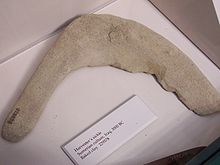Orange slice
As Orange slice in are English-speaking space sickle -cutting elements referred consisting of flint were produced. The term was introduced by J. Hamal-Nandrin and J. Servais in 1928 when they came across these shapes during excavations and called them in French " Quartier d'orange " . The flint pieces are so named because of their shape, which is reminiscent of the segment of an orange . Several of these pieces were placed together in holders (jawbones) and served as cutting segments. There is no evidence of deliberate serration of the cutting edges.
Orange slices were used from the beginning of the Neolithic Revolution and have so far mainly been discovered in Lebanon , where they were found together with axes and larger flint tools of the "Heavy Neolithic" type (large Neolithique / Gigantolithic). They are characteristic of the Qaraoun culture in and around Qaraoun in southern Lebanon. Sites were Mejdel Anjar I ( Majdal Anjar ), Dakwe I and II, Habarjer III , Qaraoun I and II, Kefraya , and Beıdar Chamout . Orange slices were excavated in large numbers near Qaraoun, from which it was concluded that they belonged to a specialized Neolithic industry .
In the meantime, other finds have been made in other regions, such as the Limbourg region .
Individual evidence
- ↑ AMT Moore: The Neolithic of the Levant. Oxford University, Unpublished Ph.D. The orange slice is godly 1978 [1]
- ↑ J. Hamal-Nandrin & J. Servais: Instruments à section triangulaire ou quadrangulaire et dont une ou deux faces sont retouchés. In: Bulletin de la Société Préhistorique Française. 25, 1928: 505-517.
- ↑ Lorraine Copeland, P. Wescombe: Inventory of Stone-Age sites in Lebanon. Imprimerie Catholique 1965: 145.
- ↑ L. Hajar, M. Haı¨dar-Boustani, C. Khater, R. Cheddadi: Environmental changes in Lebanon during the Holocene: Man vs. climate impacts. In: Journal of Arid Environments xxx, 1-10, 2009.
- ↑ EJ Peltenburg, Alexander Wasse: Council for British Research in the Levant : Maya Haïdar Boustani, Flint workshops of the Southern Beqa 'valley (Lebanon): preliminary results from Qar'oun * revolution in Neolithic: new perspectives on southwest Asia in light of recent discoveries on Cyprus. Oxbow Books 2004. ISBN 978-1-84217-132-5
- ↑ arbannig ( Memento of the original from December 21, 2016 in the Internet Archive ) Info: The archive link was inserted automatically and has not yet been checked. Please check the original and archive link according to the instructions and then remove this notice. , Rhine-Meuse-Archeology.

